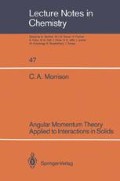Abstract
We do not go into the details of group theory here but discuss the use of the tables presented in numerous texts on group theory. An excellent text for physicists is Tinkham (1964). For our discussion here, as in section 8, we use Koster et al (1963). This reference uses the Bethe notation for the irreducible representations (Гi); the relation of the Bethe notation to the Mulligan notation (Ai, Bi etc) is given in the appendices of Griffith (1964). In our discussion we use the Bethe notation for all the single groups and both notations for the cubic 0 group. In the double groups we use only the Bethe notation.
Access this chapter
Tax calculation will be finalised at checkout
Purchases are for personal use only
Preview
Unable to display preview. Download preview PDF.
Annotated Bibliography and References
Ballhausen, C. J. (1962), Introduction to Ligand Field Theory, McGraw-Hill, New York, NY.
Griffith, J. S. (1961), The Theory of Transition-Metal Ions, Cambridge University Press, Cambridge, U. K.
Konig, E., and S. Kremer (1977), Ligand Field Energy Diagrams, Plenum Press, New York, NY. This book contains a large number of energy levels of 3dN ions in different crystalline environments. Pages 18 through 22 describe the different notation used to specify the constants (crystal-field parameters) of the system.
Koster, G. F., J. O. Dimmock, R. G. Wheeler, and H. Statz (1963), Properties of the Thirty-Two Point Groups, MIT Press, Cambridge, MA.
McClure, D. S. (1959), Electronic Spectra of Molecules and Ions in Crystals, Part II.—Spectra of Ions in Crystals, Solid State Phys. 9, 399.
Nielson, C. W., and G. F. Koster (1963), Spectroscopic Coefficients for the pn, dn, and fn Configurations, MIT Press, Cambridge, MA.
Polo, S. R. (1961, June 1), Studies on Crystal Field Theory, Volume I—Text, Volume II—Tables, RCA Laboratories, under contract to Electronics Research Directorate, Air Force Cambridge Research Laboratories, Office of Aerospace Research, contract No. AF 19(604)–5541. [Volume II gives date as June 1, 1961.]
Rotenberg, M., R. Bevins, N. Metropolis, and J. K. Wooten, Jr. (1969), The 3-j and 6-j Symbols, MIT Press, Cambridge, MA.
Tinkham, M. (1964), Group Theory and Quantum Mechanics, McGraw-Hill, New York, NY.
Author information
Authors and Affiliations
Rights and permissions
Copyright information
© 1988 Springer-Verlag Berlin Heidelberg
About this chapter
Cite this chapter
Morrison, C.A. (1988). Group Theoretical Considerations. In: Angular Momentum Theory Applied to Interactions in Solids. Lecture Notes in Chemistry, vol 47. Springer, Berlin, Heidelberg. https://doi.org/10.1007/978-3-642-93376-9_10
Download citation
DOI: https://doi.org/10.1007/978-3-642-93376-9_10
Publisher Name: Springer, Berlin, Heidelberg
Print ISBN: 978-3-540-18990-9
Online ISBN: 978-3-642-93376-9
eBook Packages: Springer Book Archive

